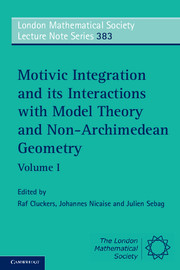Book contents
- Frontmatter
- Contents
- List of contributors
- 1 Introduction
- 2 Introductory notes on the model theory of valued fields
- 3 On the definition of rigid analytic spaces
- 4 Topological rings in rigid geometry
- 5 The Grothendieck ring of varieties
- 6 A short course on geometric motivic integration
- 7 Motivic invariants of rigid varieties, and applications to complex singularities
- 8 Motivic integration in mixed characteristic with bounded ramification: a summary
- References
4 - Topological rings in rigid geometry
Published online by Cambridge University Press: 07 October 2011
- Frontmatter
- Contents
- List of contributors
- 1 Introduction
- 2 Introductory notes on the model theory of valued fields
- 3 On the definition of rigid analytic spaces
- 4 Topological rings in rigid geometry
- 5 The Grothendieck ring of varieties
- 6 A short course on geometric motivic integration
- 7 Motivic invariants of rigid varieties, and applications to complex singularities
- 8 Motivic integration in mixed characteristic with bounded ramification: a summary
- References
Summary
Introduction
This paper gives a partial survey of the joint project [7] with K. Fujiwara (Nagoya Univ.), dealing with the part consisting of topological-ring theoretical aspects in rigid geometry, which has not been presented in our previous survey [6].
In classical algebraic geometry, finite type algebras over a field play a cornerstone role as the so-called ‘coordinate rings’, that is, the rings of regular functions on affine varieties. Scheme theory replaces affine varieties by affine schemes, and thus deals with arbitrary rings as basic building blocks. Still in scheme theory, however, fields and finite type algebras over a field keep their privileged position; fields are ‘point objects’, and finite type algebras over a field are ‘fiber objects’ over a point for locally of finite type morphisms between schemes.
In rigid geometry, on the other hand, we usually start with the so-called affinoids, that is, certain ‘affine-like’ objects, which come from topologically of finite type algebras over a complete non-archimedean valued field. This situation can be seen as an analogue of classical algebraic geometry, and thus one wants to ask for a scheme-theory-like generalization of rigid geometry. There are already several attempts to this goal; one of such attempts is via the relative rigid spaces by Bosch and Lükebohmert [1]. The most important question in these attempts is: what kind of topological rings should one start with?
- Type
- Chapter
- Information
- Motivic Integration and its Interactions with Model Theory and Non-Archimedean Geometry , pp. 103 - 144Publisher: Cambridge University PressPrint publication year: 2011



